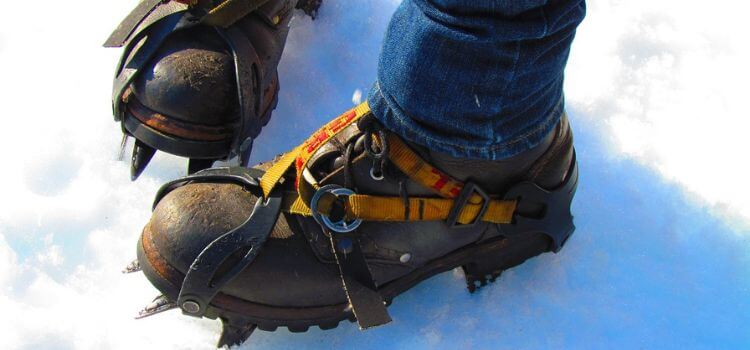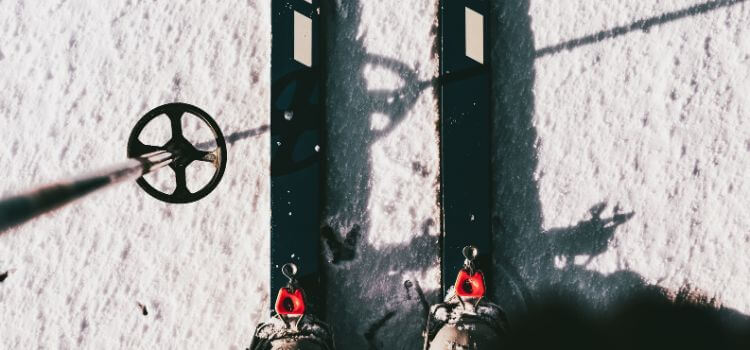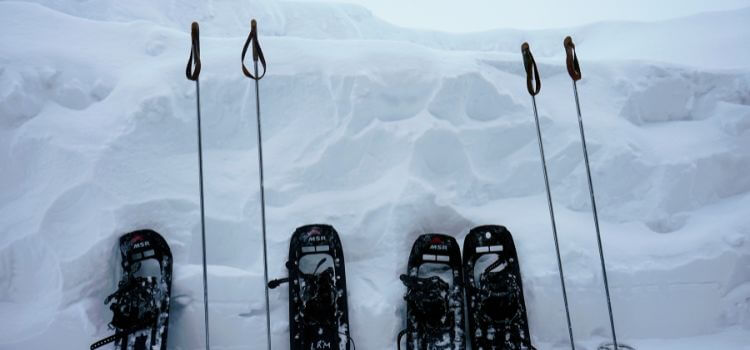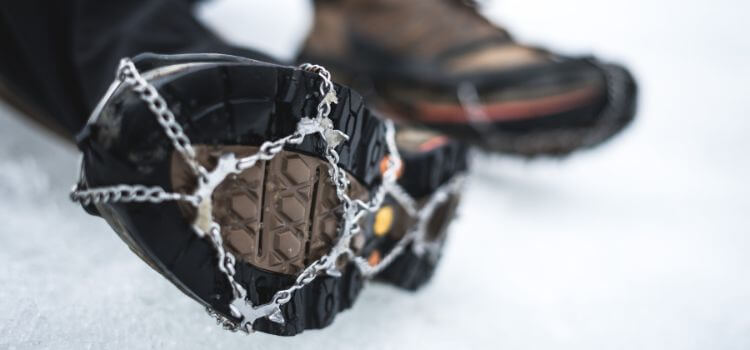To put on snow shoes, step your foot into the bindings and secure the straps snugly around your boot. Ensure the heel aligns appropriately with the snow shoe’s binding pivot point.
Snowshoeing is an exhilarating winter activity that lets adventurers easily traverse snowy terrains. Before stepping out into the frosty wilderness, knowing how to don your snow shoes properly is essential. Not only does this ensure a comfortable trek, but it also provides the needed stability and support in various snow conditions.
Outfitting yourself with the proper technique can prevent trips and slips and ensure a safe journey. This guide offers a straightforward approach to gearing up for your next snowy excursion, highlighting the importance of appropriate snowshoe fitting and security for an enjoyable and hassle-free adventure into the winter landscape.

Understanding Snowshoes
Embarking on a wintry adventure demands the right gear, and snowshoes are your ticket to mastering the snow-laden trails. Before strapping in, it’s crucial to grasp the essentials of snowshoes. These specialized accessories transform a challenging trek across the snow into an enjoyable excursion. Whether you’re a seasoned snowshoer or a beginner, understanding the different types, necessary parts, and how to select the right pair based on the terrain will set you up for a remarkable experience in the snow.
Types Of Snowshoes
There are several types of snowshoes designed to cater to a variety of needs:
- Recreational Snowshoes: Ideal for beginners and casual snowshoeing on gentle terrains.
- Backcountry Snowshoes: Built for rough terrains and off-trail adventures. These are more durable with added traction.
- Running Snowshoes: Created for snowshoe runners, they are lightweight and have a streamlined design.
- Racing Snowshoes: The lightest option for speed and agility in competitive snowshoeing.
Essential Parts Of Snowshoes
Understanding the essential parts of snowshoes is fundamental:
| Part | Function |
| Frame | Defines the snowshoe’s shape and provides support. |
| Decking | Attached to the structure, the decking is the surface area that supports your weight on the snow. |
| Bindings | Secure your boots to the snowshoes. |
| Crampons | Metal teeth underfoot provide traction on icy terrain. |
| Heel lifts (Televators) | Reduce calf strain and increase traction while climbing steep slopes. |
Choosing The Right Snowshoes Based On The Terrain
Selecting the perfect pair of snowshoes correlates with the terrain you plan to explore:
- Flat Terrain: Simple snowshoes with easy-to-use bindings are perfect for beginners or those looking to stroll on established trails.
- Rolling Terrain: Choose snowshoes with more aggressive crampons and a more substantial build to handle varied, undulating landscapes.
- Mountainous Terrain: Opt for robust snowshoes featuring advanced binding systems and heel lifts to tackle steep ascents and treacherous conditions.
Determine your primary snowshoeing activities. Are you aiming for peaceful hikes, intense climbs, or long-distance treks? Your preferred actions significantly influence your choice of snowshoes, laying the foundation for unforgettable snowy explorations.
Preparing Your Gear
Before stepping out into a winter wonderland, gearing up is crucial for a successful snowshoeing adventure. This isn’t just about strapping on the snowshoes; it’s also about choosing the proper boots, dressing appropriately, and packing essential accessories. Let’s break down what you need for your snowy trek.

Selecting Proper Winter Boots
Finding the proper boots is the cornerstone of preparing for snowshoeing. They must be waterproof and insulated to hold your feet hot and dry. Here are key pointers:
- Fit: Make sure there’s enough room for thick socks. Boots should be snug but not tight.
- Height: High-cut boots offer better ankle support and protection from deep snow.
- Sole: Look for sturdy soles with deep lugs for extra grip on ice and snow.
Adjusting Your Clothing For Snowshoeing
Dress in layers to organize your body temperature. A three-layer system typically works well:
- Base Layer: Opt for moisture-wicking fabrics to keep skin dry.
- Insulating Layer: Fleece or down provides warmth.
- Outer Layer: Waterproof and breathable shell to cover against the elements.
Remember a hat, gloves, and gaiters to shield your extremities from the cold.
Taking Essential Accessories For A Safe And Enjoyable Experience
A successful excursion is about more than just the proper boots and layers. It includes packing must-have accessories. Here’s what should be on your checklist:
| Accessory | Function |
| Poles | Extra stability and balance. |
| Backpack | Carry essentials and layers. |
| Water and Snacks | Stay hydrated and energized. |
| First-Aid Kit | Handle unexpected injuries. |
| Headlamp | Visibility during early or late trips. |
| Sun Protection | Sunglasses and sunscreen to guard against glare and UV rays. |
Remember to inform others of your route and expected return time. Safety is paramount; never underestimate the importance of preparation and awareness.
How To Put On Snow Shoes
Embracing the winter wonderland involves hiking through snow on trusty snowshoes. Knowing how to put on snowshoes adequately is critical to enjoying your excursion to the fullest. It isn’t just about slipping your foot in and marching off; it requires precision to secure the bindings and adjust the straps to ensure a comfortable, stable, and safe adventure. Follow these steps to ensure your snow shoes provide the best support, balance, and comfort.
Securing The Bindings
Getting the bindings right is the cornerstone of a good snowshoe experience. Take these steps:
- Place your snowshoe on a flat surface.
- Step your foot into the bindings, centering your boot on the snowshoe deck.
- Ensure the ball of your foot aligns with the hinge or pivot point of the snowshoe for optimal articulation.
- Pull the front binding strap across your toes and secure it firmly.
- Repeat with the heel strap, checking that your foot is secure but not overly tightened.
Adjusting The Straps For A Snug Fit
Once your bindings are in place, it’s time to adjust the straps for a compact fit. Well-fitted straps will help avoid uncomfortable pressure points and ensure your snowshoes stay on, regardless of terrain.
- Start by gently pulling each strap until the snowshoe snugly embraces your foot.
- Avoid over-tightening, as it can hinder circulation and movement.
- Ensure equal pressure distribution to prevent one area from becoming sore as you trek.
- Tuck away any excess strap material to avoid tripping hazards.
Maintaining Proper Posture For Balance And Stability
With your snowshoes secure, maintain proper posture for the best stability and balance. Keep these tips in mind:
- Stand up direct with your weight evenly distributed across both snowshoes.
- Bend your knees slightly for better shock absorption and agility.
- Lean slightly forward when ascending hills and backward when descending to maximize control.
- Regularly check the straps and bindings for any signs of loosening.
- Engage your core muscles to alleviate the leg load and enhance overall steadiness.
Walking In Snowshoes
Mastering the art of walking in snowshoes opens up a winter wonderland of adventure. It’s a unique form of travel that requires understanding the snow beneath your feet and the rhythm of your body. The following tips and techniques will ensure your snowshoeing outing is successful and thoroughly enjoyable.

Techniques For Walking On Different Snow Types
Different types of snow pose various challenges and demand specific techniques:
- Powdery Snow: Lift your knees slightly to avoid dragging the snowshoes and wasting energy.
- Packed Snow: A regular walking stride works well, and the snowshoes provide additional traction.
- Crusty Surface: Be cautious as the crust may break. Apply gentle pressure initially to test the surface.
- Deep Snow: Use the “stomping” technique to compact the snow beneath you for better support.
Navigating Hilly Terrain
Ascending and descending hills in snowshoes calls for special attention:
- Going Up: Kick the front of the snowshoe into the slope to create a step. Lean forward to maintain balance.
- Going Down: Lean back slightly and use the tails of the snowshoes for braking. Take shorter, careful steps.
- Side-Hilling: Keep your weight on the uphill edges of the snowshoes to prevent sliding down the slope.
Tips For Maintaining Momentum And Avoiding Fatigue
To keep your energy up and enjoy a more extended journey:
- Maintain a steady pace that matches your fitness level.
- Use poles to help propel you forward and maintain balance.
- Take regular, short breaks for hydration and rest.
- Practice efficient movements to minimize unnecessary exertion.
- Wear layers to manage body temperature and prevent sweating.
Staying Safe And Comfortable
Embarking on a snowshoe adventure calls for preparation beyond selecting picturesque trails. The majesty of a winter wonderland often conceals potential challenges, so safety should remain at the forefront of any snowshoer’s mind. Awareness of your body’s needs and the terrain’s treachery is crucial in ensuring an enjoyable and comfortable outing. Let’s dive into critical considerations for maintaining safety and comfort while you traverse the frosty environment.
Knowing Your Limits And The Signs Of Exhaustion
Recognizing personal endurance thresholds is essential when snowshoeing. Listen to your body’s signals and be mindful of these key exhaustion indicators:
- Dizziness
- Excessive fatigue
- Shortness of breath
Should these symptoms arise, take a break, hydrate, and evaluate if it’s safe to continue. Understanding and respecting these limits ensures safety and enhances the pleasure of your snowshoe excursion.

Navigating Hazards Like Icy Patches And Deep Snow
Various terrain challenges await in the snowy landscapes. Stay vigilant for:
| Hazard Type | Precautionary Measures |
| Icy Patches | Use poles for stability, walk flat-footed, and avoid sudden movements. |
| Deep Snow | Maintain an even pace and use a high-stepping gait to prevent fatigue. |
These strategies help mitigate risk and keep your snowshoeing session secure and delightful.
Tips For Caring For Your Gear And Staying Warm Throughout The Adventure
Maintaining your equipment and personal warmth is paramount to any winter excursion. Follow these tips:
- Post-use, dry your snowshoes and check for any damage.
- Layer your clothing to manage body temperature effectively.
- Waterproof gloves and boots are essential for comfort and preventing frostbite.
- Pack extra socks and insulation layers for longer journeys.
These practices extend your gear’s life and ensure you stay warm and primed for the winter adventures ahead.
Frequently Asked Questions For How To Put On Snow Shoes
How Do You Put On Snowshoes?
Place snowshoes flat on the snow. Step into bindings, the first. Secure the front straps, ensuring a snug fit. Fasten the heel strap tightly. Check all belts for firmness before starting your walk.
How Do You Fit Yourself For Snowshoes?
Select snowshoes that match your weight, including gear. Ensure straps are tight on your boots for a secure fit. Adjust bindings for comfort and stability, keeping toes just behind the hinge. Check for even weight distribution and walk naturally.
How Do You Strap On Snowshoes?
Place your foot in the snowshoe’s bindings. Secure the heel strap tightly. Adjust the front straps snugly across your foot. Ensure even weight distribution. Double-check all straps for firmness before starting your trek.
Are Snow Shoes Supposed To Be Tight?
Snowshoes should fit snugly yet allow some movement for comfort; they shouldn’t be so tight that they restrict circulation or cause discomfort.
Conclusion
Strapping on snowshoes is a simple process once you know the tricks. With the steps outlined, you’ll navigate snowy trails like a pro. Remember, practice leads to perfect fit and comfort. Now, gear up and embrace the winter wonderland with confidence.
Happy trekking!
Related posts:
- Are Skateboarding Shoes Good For Walking
- What Are The Most Comfortable Safety Shoes
- How To Wash Wrestling Shoes
- How To Clean Work Shoes
- What Are Lifestyle Sneakers
- How To Clean Bowling Shoes Slide Strip
- Are Vans Shoes Good For Walking
- How Long Do Slippers Last? Uncover the Lifespan Secrets!
- Do-Win Classic Lifter: Elevate Your Weightlifting Performance
- Where To Find Dance Shoes: Top Stores and Online Shops
